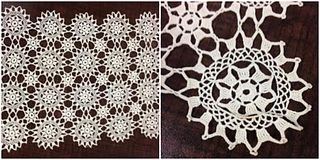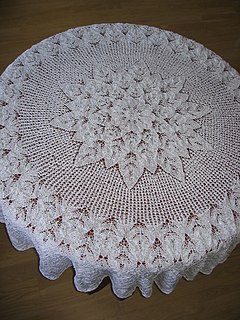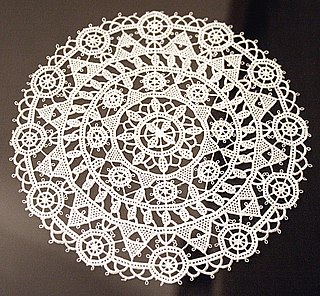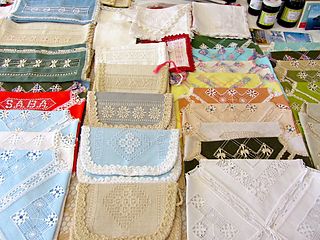 W
WLace is a delicate fabric made of yarn or thread in an open weblike pattern, made by machine or by hand. Generally, lace is divided into two main categories, needlelace and bobbin lace. There are other types of lace, such as knitted or crocheted lace. Other laces such as these are considered as a category of their specific craft. Knitted lace, therefore, is an example of knitting. This article considers both needle lace and bobbin lace.
 W
WThe Anglo Scotian Mills is former lace factory in Beeston, Nottinghamshire. It is a Grade II listed building.
 W
WCambric, or batiste, one of the finest and densest kinds of cloth, is a lightweight plain-weave cloth, originally from the French commune of Cambrai, woven greige, then bleached, piece-dyed and often glazed or calendered. Initially it was made of linen; later, the term came to be applied to cotton fabrics as well. Chambray is the same type of fabric, with a coloured warp and white filling; the name "chambray" replaced "cambric" in the United States in the early 19th century.
 W
WThe Cité de la Dentelle et de la Mode is a museum of lace in Pas de Calais in northern France. It is one of two museums in France to celebrate machine lace making. The museum is an Anchor point on the European Route of Industrial Heritage.
 W
WA doily is an ornamental mat, typically made of paper or fabric, and variously used for protecting surfaces or binding flowers, in food service presentation, or as a head covering or clothing ornamentation. It is characterized by openwork, which allows the surface of the underlying object to show through.
 W
WRosa Elena Egipciaco, often referred to as the 'Queen of Mundillo', is a master Mundillo lacemaker and teacher of the Puerto Rican folk art. In addition to being part of the long Mundillo tradition of her hometown of Moca, Puerto Rico, she belongs to the much larger, much longer tradition of Spanish and European bobbin lacemaking.
 W
WEmbroidered lace is embroidered on a base using a needle. The base varies according to the type.
 W
WA Faroese shawl is a traditional piece of clothing from the Faroe Islands. The most distinguishing characteristic of Faroese shawls is the center back gusset shaping. Each shawl consists of two triangular side panels, a trapezoid-shaped back gusset, an edge treatment, and usually shoulder shaping. The shoulder shaping allows these shawls to drape over the shoulders and remain in place as the wearer moves, even if the shawl is not pinned in place.
 W
WGimp is a narrow ornamental trim used in sewing or embroidery. It is made of silk, wool, polyester, or cotton and is often stiffened with metallic wire or coarse cord running through it. Gimp is used as trimming for dresses, curtains, furniture, etc. Originally the term referred to a thread with a cord or wire in the center, but now is mainly used for a trimming braided or twisted from this thread. Sometimes gimp is covered in beads or spangles.
 W
WGreek lace is considered one of the earliest forms of all lace. Some types of Greek lace include reticella, Roman lace, cutwork, Venetian guipure, and Greek point lace
 W
WIpswich lace is a historical fashion accessory, the only known American hand-made bobbin lace to be commercially produced. Centered in the coastal town of Ipswich, Massachusetts north of Boston, a community of lacemaking arose in the 18th century. Earliest known records indicate that lace produced by local women was used to barter for goods in the 1760s, as denoted by ledger account books belonging to local merchants. These laces were sold in the region from Boston to Maine.
 W
WLace knitting is a style of knitting characterized by stable "holes" in the fabric arranged with consideration of aesthetic value. Lace is sometimes considered the pinnacle of knitting, because of its complexity and because woven fabrics cannot easily be made to have holes. Famous examples include the Orenburg shawl and the wedding ring shawl of Shetland knitting, a shawl so fine that it could be drawn through a wedding ring. Shetland knitted lace became extremely popular in Victorian England when Queen Victoria became a Shetland lace enthusiast. Her enthusiasm resulted i.a. in her choosing knitted lacework for presents; e.g. when in ca. 1897 the Queen gave a lace shawl as a present to American abolitionist Harriet Tubman. From there, knitting patterns for the shawls were printed in English women's magazines where they were copied in Iceland with single ply wool.
 W
WThe Lace Market is a historic quarter-mile square area of Nottingham, England. It was the centre of the world's lace industry during the British Empire and is now a protected heritage area. It was an area of salesrooms and warehouses for storing, displaying and selling the lace. The Lace Market adjoins Hockley, and both areas now accommodate a variety of bars, restaurants and shops.
 W
WLacemaking in Croatia is a tradition dating back to the Renaissance when lacemaking began spreading throughout the Mediterranean and continental Europe. Throughout the years, Croatian lace has become notable for its unique patterns and designs. In 2009, UNESCO recognised lacemaking in Croatia as an Intangible Cultural Heritage of Humanity.
 W
WLefkaritika or Lefkara Lace is a handmade lace from Pano Lefkara Cyprus. Notable characteristics are the hemstitch, satin stitch fillings, needlepoint edgings, white, brown, ecru colours and geometric intricate patterns. in 2009, this traditional craft of lace-making was inscribed on the Representative List of the Intangible Cultural Heritage.
 W
WThe Lippitt Mill is an historic mill at 825 Main Street in West Warwick, Rhode Island.
 W
WMacramé is a form of textile produced using knotting techniques.
 W
WMetal lace describes a type of lace made from metal or metallic threads, such as gold, silver, or copper. The designs can be worked on a textile ground, or the lace can completely be made from metallic threads. It is mainly used as an embellishment for military uniforms, fashionable, ceremonial and theatrical dress, and ecclesiastical textiles.
 W
WMorosina Morosini-Grimani, was a Venetian patrician. She was the Dogaressa of Venice from 1595 to 1606.
 W
WMundillo is a craft of handmade bobbin lace that is cultivated and honored on the island of Puerto Rico and Panama. The term 'mundillo' means 'little world', referring to the cylindrical pillow on which the lace maker ('Mundillista') weaves intricate designs. The decorative lace is created using wooden bobbins about the diameter of a pencil, which are wound with thread that is twisted and crossed to form a pattern. Depending on the pattern, as few as two dozen or as many as several hundred bobbins may be used.
 W
WMusée des Beaux-arts et de la Dentelle d'Alençon is an art museum located in Alençon, France.
 W
WThe Orenburg shawl is a Russian knitted lace textile using goat down and stands as one of the classic symbols of Russian handicraft, along with Tula samovars, the Matrioshka doll, Khokhloma painting, Gzhel ceramics, the Palekh miniature, Vologda lace, Dymkovo toys, Rostov finift (enamel), and Ural malachite.
 W
WPassementerie or passementarie is the art of making elaborate trimmings or edgings of applied braid, gold or silver cord, embroidery, colored silk, or beads for clothing or furnishings.
 W
WSaba lace or as it was known in the early period, Spanish Work, is a handcrafted art of needlework designs which began as a cottage industry on the Caribbean island of Saba at the end of the 19th century and grew into one of the leading industries on the island at the turn of the 20th century. Until the 1950s, lacework was one of the key sources of revenue to the island's economy. The handicraft is still practiced and is a feature of tourism for the island, having been the focus of two books on the subject, as well as a winner of the Prince Bernhard Caribbean Culture Prize.
 W
WThe Scranton Lace Company, also known as the Scranton Lace Curtain Company and Scranton Lace Curtain Manufacturing Company, was an American lace manufacturer in Scranton, Pennsylvania.
 W
WSprang is an ancient method of constructing fabric that has a natural elasticity. Its appearance is similar to netting, but unlike netting sprang is constructed entirely from warp threads. Archaeological evidence indicates that sprang predates knitting; the two needlework forms bear a visible resemblance and serve similar functions but require different production techniques.
 W
WTatting is a technique for handcrafting a particularly durable lace from a series of knots and loops. Tatting can be used to make lace edging as well as doilies, collars, accessories such as earrings and necklaces, and other decorative pieces. The lace is formed by a pattern of rings and chains formed from a series of cow hitch or half-hitch knots, called double stitches, over a core thread. Gaps can be left between the stitches to form picots, which are used for practical construction as well as decorative effect.
 W
WThe Lace Guild is a registered charity, accredited museum and educational organisation based in the UK for lacemakers and those interested in lacemaking. Its aims are to provide information about the craft of lacemaking, its history and use, to promote a high standard of lacemaking, and to encourage the design, development and professional presentation of lace. It is a registered educational charity.
 W
WBarbara Uthmann was considered to be one of the greatest supporters of bobbin lace making and was a successful businesswoman in the Ore Mountains. Her last name has sometimes been spelled Uttmann, but the spelling Uthmann is generally considered to be correct today.
 W
WFederico de Vinciolo or Federico Vinciolo was a sixteenth-century lace-maker and pattern designer attached to the court of Henry II of France. He was granted a monopoly on manufacturing lace ruffs in France.